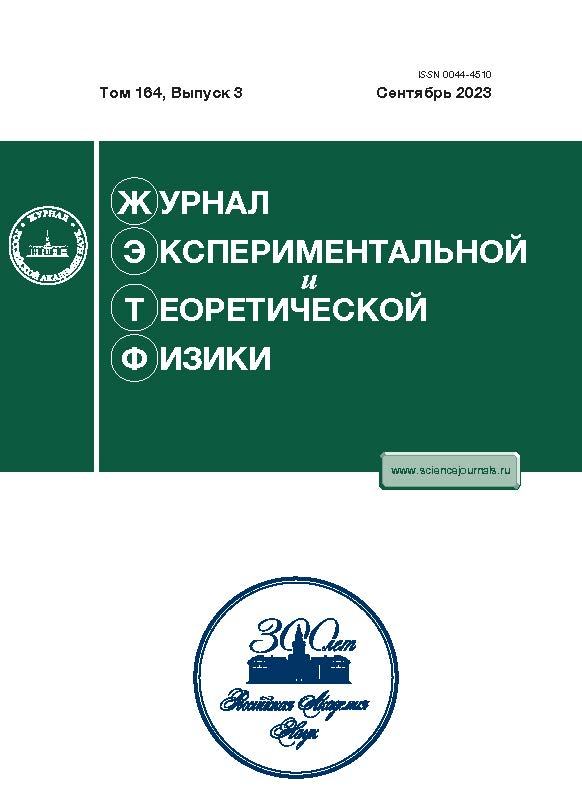Planar Defects as a Way to Account for Explicit Anharmonicity in High Temperature Thermodynamic Properties of Silicon
- Авторлар: Kondrin M.V.1, Lebed' Y.B.2, Brazhkin V.V.1
-
Мекемелер:
- Institute for High Pressure Physics, Russian Academy of Sciences
- Institute for Nuclear Research, Russian Academy of Sciences
- Шығарылым: Том 164, № 3 (2023)
- Беттер: 396-405
- Бөлім: Articles
- URL: https://transsyst.ru/0044-4510/article/view/653654
- DOI: https://doi.org/10.31857/S0044451023090080
- EDN: https://elibrary.ru/KCTUCX
- ID: 653654
Дәйексөз келтіру
Аннотация
Silicon is indispensable in semiconductor industry. Understanding its high-temperature thermodynamic properties is essential both for theory and applications. However, first-principle description of high-temperature thermodynamic properties of silicon (thermal expansion coefficient and specific heat) is still incomplete. Strong deviation of its specific heat at high temperatures from the Dulong–Petit law suggests substantial contribution of anharmonicity effects. We demonstrate, that anharmonicity is mostly due to two transverse phonon modes, propagating in (111) and (100) directions, and can be quantitatively described with formation of the certain type of nanostructured planar defects of the crystal structure. Calculation of these defects' formation energy enabled us to determine their input into the specific heat and thermal expansion coefficient. This contribution turns out to be significantly greater than the one calculated in quasi-harmonic approximation.
Авторлар туралы
M. Kondrin
Institute for High Pressure Physics, Russian Academy of Sciences
Email: mkondrin@hppi.troitsk.ru
Troitsk, Moscow, 108840 Russia
Yu. Lebed'
Institute for Nuclear Research, Russian Academy of Sciences
Email: mkondrin@hppi.troitsk.ru
Moscow, 117312 Russia
V. Brazhkin
Institute for High Pressure Physics, Russian Academy of Sciences
Хат алмасуға жауапты Автор.
Email: mkondrin@hppi.troitsk.ru
Troitsk, Moscow, 108840 Russia
Әдебиет тізімі
- L. Landau, L. Pitaevskii, and E. Lifshitz, Statistical Physics, Course of Theoretical Physics, Pergamon Press, Oxford (1980).
- C. A. Swenson, J. Phys. Chem. Ref. Data 12, 179 (1983).
- M. Born and E. Brody, Z. Physik 6, 132 (1921).
- D. C. Wallace, Phys. Rev. 139, A877 (1965).
- R. A. Cowley, Rep. Progr. Phys. 31, 123 (1968).
- D. Gerlich, B. Abeles, and R. E. Miller, J. Appl. Phys. 36, 76 (1965).
- P. D. Desai, J. Phys. Chem. Ref. Data 15, 967 (1986).
- K. Yamaguchi and K. Itagaki, J. Therm. Anal. Calorimetry 69, 1059 (2002).
- L. Maissel, J. Appl. Phys. 31, 211 (1960).
- H. Watanabe, N. Yamada, and M. Okaji, Int. J. Thermophys. 25, 221 (2004).
- B. N. Dutta, Phys. Stat. Sol. (b) 2, 984 (1962).
- Y. Okada and Y. Tokumaru, J. Appl. Phys. 56, 314 (1984).
- R. B. Roberts, J. Phys. D: Appl. Phys. 14, L163 (1981).
- B. Grabowski, L. Ismer, T. Hickel et al., Phys. Rev. B 79, 134106 (2009).
- D. S. Kim, O. Hellman, J. Herriman et al., Proc. Nat. Acad. Sci. 115, 1992 (2018).
- M. Kondrin, Y. Lebed, and V. Brazhkin, Diamond Relat. Mater. 110, 108114 (2020).
- M. V. Kondrin, Y. B. Lebed, and V. V. Brazhkin, Phys. Rev. Lett. 126, 165501 (2021).
- M. Kondrin, Y. Lebed, and V. Brazhkin, Phys. Stat. Sol. (b) 259, 2100463 (2022).
- А. И. Савватимский, С. В. Онуфриев, УФН 190, 1085 (2020)
- A. I. Savvatimskii and S. V. Onufriev, Phys. Usp. 63, 1015 (2020).
- A. Savvatimskiy, S. Onufriev, and A. Kondratyev, Carbon 98, 534 (2016).
- A. M. Kondratyev and A. D. Rakhel, Phys. Rev. Lett. 122, 175702 (2019).
- J. Vanhellemont, A. K. Swarnakar, and O. V. der Biest, ECS Transactions 64, 283 (2014).
- В. А. Гончарова, Е. В. Чернышева, Ф. Ф. Воронов, ФTT 25, 3680 (1983).
- D. S. Kim, H. L. Smith, J. L. Niedziela et al., Phys. Rev. B 91, 014307 (2015).
- S. Wei, C. Li, and M. Y. Chou, Phys. Rev. B 50, 14587 (1994).
- C. Wang, J. Gu, X. Kuang et al., Z. Naturforschung A 70 (2015); https://dx.doi.org/10.1515/zna-2015-0027.
- A. R. Oganov and C. W. Glass, J. Chem. Phys. 124, 244704 (2006).
- Q. Li, Y. Ma, A. R. Oganov et al., Phys. Rev. Lett. 102, 175506 (2009).
- C. He, L. Sun, C. Zhang et al., Sol. St.Commun. 152, 1560 (2012).
- J. P. Goss, P. R. Briddon, R. Jones et al., Phys. Rev. B 73, 115204 (2006).
- V. L. Deringer, G. Cs'anyi, and D. M. Proserpio, Chem. Phys. Chem. 18, 873 (2017).
- P. Giannozzi, O. Andreussi, T. Brumme et al., J. Phys.: Condens. Matter 29, 465901 (2017).
- T. Bj¨orkman, Comp. Phys.Commun. 182, 1183 (2011).
- L. Balogh, G. Rib'arik, and T. Ung'ar, J. Appl. Phys. 100, 023512 (2006).
- T. R. Hart, R. L. Aggarwal, and B. Lax, Phys. Rev. B 1, 638 (1970).
- P. C. Trivedi, H. O. Sharma, and L. S. Kothari, J. Phys. C: Sol. St. Phys. 10, 3487 (1977).
- В. А. Грешняков, Письма в ЖЭТФ 117, 306 (2023)
- V. A. Greshnyakov, JETP Lett. 117, 306 (2023).
- J. Men'endez and M. Cardona, Phys. Rev. B 29, 2051 (1984).
- A. Debernardi, S. Baroni, and E. Molinari, Phys. Rev. Lett. 75, 1819 (1995).
- S. Klotz, J. M. Besson, M. Braden et al., Phys. Rev. Lett. 79, 1313 (1997).
- В. В. Бражкин, С. Г. Ляпин, И. А. Троян и др., Письма в ЖЭТФ 72, 279 (2000)
- V. V. Brazhkin, S. G. Lyapin, I. A. Trojan et al., JETP Lett. 72, 195 (2000).
Қосымша файлдар









